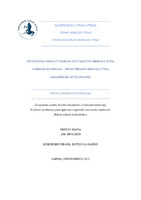| dc.contributor.advisor | PATSOULA, ELENI | |
| dc.contributor.author | Μπρίζη, Μαρία | |
| dc.date.accessioned | 2023-10-11T10:57:19Z | |
| dc.date.available | 2023-10-11T10:57:19Z | |
| dc.date.issued | 2023-09-29 | |
| dc.identifier.uri | https://polynoe.lib.uniwa.gr/xmlui/handle/11400/5292 | |
| dc.identifier.uri | http://dx.doi.org/10.26265/polynoe-5130 | |
| dc.description.abstract | Εισαγωγή: Ο σύγχρονος τρόπος ζωής και η ολοένα αυξανόμενη τάση προς την
κατανάλωση φρούτων και λαχανικών, τα οποία αποτελούν πηγές βιταμινών,
ιχνοστοιχείων και φυτικών ινών, έχει οδηγήσει στην αυξημένη κατανάλωση νωπών
βρώσιμων προϊόντων σε καθημερινή βάση. Ωστόσο, αυτά κάτω από συγκεκριμένες
συνθήκες, όπως το μη επαρκές πλύσιμο, δύνανται να αποτελέσουν πηγές μετάδοσης
πρωτοζωικών παρασιτικών οργανισμών, όπως είναι το Toxoplasma gondii, η Giardia
duodenalis και το Cryptosporidium parvum.
Σκοπός και στόχοι: Σκοπός αυτής της εργασίας είναι να προσδιοριστούν οι κίνδυνοι
μετάδοσης των προαναφερθέντων μικροοργανισμών μέσω της βρώσης νωπών
λαχανικών και φρούτων, να αναδειχθούν πιθανά αίτια και τέλος να προταθούν, εφόσον
είναι εφικτό, μέτρα προστασίας των καταναλωτών.
Μεθοδολογία: Για το σκοπό αυτό συγκεντρώθηκε βιβλιογραφία στη βάση δεδομένων
PubMed, για το χρονικό διάστημα 2013-2023. Η αναζήτηση έγινε με κατάλληλες
λέξεις-κλειδιά, όπως fresh fruits, fresh vegetables, fresh products, Giardia duodenalis,
Toxoplasma gondii, Cryptosporidium parvum και συνδυασμούς αυτών. Η διαδικασία
ανεύρεσης των άρθρων πραγματοποιήθηκε σε δύο στάδια. Το πρώτο στάδιο, όπου
έγινε προβολή του τίτλου και της περίληψης και το δεύτερο στάδιο όπου έγινε προβολή
όλου του κειμένου.
Αποτελέσματα: Αρχικά προέκυψαν 194 άρθρα, από τα οποία εφαρμόζοντας τα
κριτήρια που θέσαμε, καταλήξαμε σε 20. Σε αυτές τις μελέτες γίνεται αντιληπτό ότι ο
επιπολασμός των φρέσκων λαχανικών και φρούτων είναι αρκετά αυξημένος. Η
πλειοψηφία των μελετών αναφέρει τα φυλλώδη λαχανικά ως τα πιο ευαίσθητα και
μάλιστα το μαρούλι κατέχει σημαντικό προβάδισμα σε ποσοστά παρασιτικής
μόλυνσης. Τέλος, η χρήση μολυσμένου νερού για άρδευση και ξέπλυμα των προϊόντων
θεωρείται ως η πιθανότερη πηγή μόλυνσης.
Συμπεράσματα και προτάσεις: Λόγω του ότι οι τροφιμογενείς λοιμώξεις αποτελούν
μείζον θέμα Δημόσιας Υγείας και συχνά διαφεύγουν του συστήματος καταγραφής
εξαιτίας ασυμπτωματικής νόσησης, θα ήταν σκόπιμο να παρθούν αυστηρότερα μέτρα
και οδηγίες, τόσο προς τους παραγωγούς και χειριστές τροφίμων, όσο και ως προς τους
καταναλωτές. | el |
| dc.format.extent | 77 | el |
| dc.language.iso | el | el |
| dc.publisher | Πανεπιστήμιο Δυτικής Αττικής | el |
| dc.rights | Αναφορά Δημιουργού - Μη Εμπορική Χρήση - Παρόμοια Διανομή 4.0 Διεθνές | * |
| dc.rights.uri | https://creativecommons.org/licenses/by-nc-sa/4.0/deed.el | * |
| dc.subject | Tροφιμογενείς λοιμώξεις | el |
| dc.subject | Nωπά φρούτα | el |
| dc.subject | Nωπά λαχανικά | el |
| dc.subject | Ζωονόσοι | el |
| dc.subject | Παρασιτικά πρωτόζωα | el |
| dc.subject | Fresh fruits | el |
| dc.subject | Fresh vegetables | el |
| dc.subject | Foodborne infections | el |
| dc.subject | Protozoan parasites | el |
| dc.title | Toxoplasma gondii, Giardia duodenalis, Cryptosporidium spp: Κίνδυνοι μετάδοσης μέσω φρέσκων λαχανικών και νωπών προϊόντων -Βιβλιογραφική ανασκόπηση | el |
| dc.title.alternative | Toxoplasma gondii, Giardia duodenalis, Cryptosporidium spp: The risks of transmission through fresh vegetables and fresh products -Literature review | el |
| dc.type | Μεταπτυχιακή διπλωματική εργασία | el |
| dc.contributor.committee | PAPADOGIANNAKIS, E. | |
| dc.contributor.committee | TEGOS, NIKOLAOS | |
| dc.contributor.faculty | Σχολή Δημόσιας Υγείας | el |
| dc.contributor.department | Τμήμα Πολιτικών Δημόσιας Υγείας | el |
| dc.contributor.master | Δημόσιας Υγείας | el |
| dc.description.abstracttranslated | Introduction: The modern lifestyle and the current trend of eating more fruits and
vegetables, which are sources of vitamins, minerals and fibers, has led to increased
consumption of fresh edible products on a daily basis. However, under certain
conditions, such as insufficient washing, these can be potential sources of transmission
of protozoan parasites, such as Toxoplasma gondii, Giardia duodenalis and
Cryptosporidium parvum.
Purpose and objectives: The aim of this study is to identify the risks of transmission of
the above mentioned parasitic micro-organisms through the consumption of fresh
vegetables and fruits, to identify possible causes and finally to propose, if feasible,
consumer protection measures.
Methodology: For this purpose, literature was collected in the PubMed database for the
period 2013-2023. The search was performed using appropriate keywords,such as fresh
fruits, fresh vegetables, fresh products, Toxoplasma gondii, Giardia duodenalis and
Cryptosporidium parvum and combinations of them. The article retrieval process was
carried out in two stages. The first regarding title and abstract viewing, and the second
stage where the entire text was viewed.
Results: Initially, 194 articles were obtained, and after applying specific criteria sets,
we reached to 20. In these studies, it can be seen that the prevalence of fresh vegetables
and fruits is quite high. The majority of the studies mention leafy vegetables as the most
susceptible, and even lettuce has a significant impact in parasitic infection rates. Finally,
the use of contaminated water for irrigation and rinsing of produce is considered the
most likely source of contamination.
Conclusions and recommendations: Due to the fact that foodborne infections are a
major Public Health issue, and often escape the recording system due to asymptomatic
illness, it would be advisable to take more strict measures and guidelines, both towards
food producers and food handlers, as well as consumers.
Key words: foodborne infections, foodborne parasitic protozoa, fresh fruits, fresh
vegetables, leafy vegetables, zoonosis | el |


